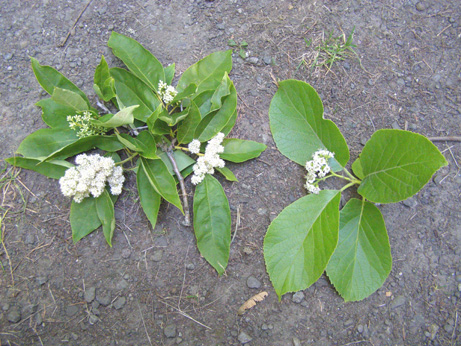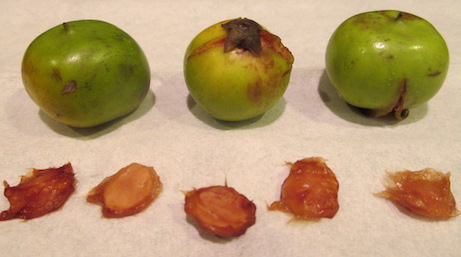Plant of the Month: July 2007
|
| EHRET TREES |
BORAGINACEÆ; (EHRETIACEÆ or CORDIACEÆ) Borage Family
|
The genus Ehretia was named in 1756 after George Dionysius Ehret (1708 - 1770), German-English botanical artist. Ehretia consists of 40 to 75 species of widely distributed shrubs and trees, primarily tropical or subtropical, mostly in the Old World. Several species are all very rarely cultivated in the United States, and are desirable primarily for their showy, sweetly fragrant flowers. Their nomenclature has often been confused. Though I was familiar with several of Ehretia species for at least 15 years, it was only this month, on July 4th, when I saw and smelled two species in bloom, that I grew excited, and therefore now share this account with you.
|
| 1) Ehretia Dicksonii Hance 1862 |
| = E. macrophylla hort., sensu auct. Japon, non Wall. in Roxb. 1824 |
| From Bhutan, Nepal, China, Taiwan, Viet Nam, Japan, the Ryukyus. |
| Ehretia Dicksonii was named in 1862 after Walter George Dickson (1821 - 1894), author of Narrative of an overland trip, through Hunan, from Canton to Hankow published in 1861. Ehretia Dicksonii was introduced to Western cultivation in 1897 by Ernest Wilson. It is still very rare, though has been in North American commerce since at least 1940. Forest Farm nursery of Williams, Oregon, offered it from at least 1991 through 1997 --and likely before and after as well. At present I know no mail-order U.S. sources. |
| It is a gawky large shrub or bold tree; the antithesis of dainty. The bark is gray and corky; twigs are stout, with scattered rough hairs when young, or hairless. The leaves are thick and large, to 8 inches long by 4.5 inches wide (sucker leaves are up to 13 inches by 7.5 inches); the stem five-eighths to 2 inches. The leaves are raspy hairy (sandpaper texture) on top, felty beneath, but are variable and can be nearly hairless. They are thick, leathery, mildly rugose; toothed; can be glossy above; the base is rounded or cordate; they stay green late into fall, without lovely autumnal coloration. (A Chinese name, Ts'u K'ang Shu, means Coarse-chaff Tree.) The joy of the tree is its white or slightly yellowish flowers, sweetly fragrant, borne in 2 to 4 inch wide terminal clusters in June and early July. The fragrance is so strong as to almost be amazing. The ensuing fruit is a berry, (greenish-yellow) yellow or orange, hairless, one-half to one and one-eighths of an inch wide, 2- (3) seeded. |
| Other than its role as an ornamental tree, there may be more: A 1999 study from Gifu University, Japan, found that a "methanol extract . . . provided . . . an anti-inflammatory compound . . . that suppressed induced inflammation on mouse ears." |
Ehretia Dicksonii is extremely rare in Seattle; other than the two cited below, only 1 young tree is known to me here, 7 feet tall in a back yard. If any readers know of others, please notify me.
|
- Washington Park Arboretum: a 1990 accession is 41.5 feet tall; 2 feet 1 inch trunk circumference (#454-90) in grid 15-1E, growing in moist heavy soil, 11 feet from a smaller Ehretia acuminata.
|
- Chittenden Locks bed number 327 has one planted in the 1990s that was cut to the ground in 2003, but regrew and is now 15 feet tall. It is squeezed between 2 Trochodendron trees, a pink-flower Star magnolia, and a big Gray (Digger) pine.
|
Record sizes measured elsewhere:
|
| 65 feet tall; 7 feet 4 inches trunk circumference. |
Parc de Bagatelle, Paris, France (1982; planted in 1897)
|
| 55.5 feet tall; 4 feet 3 inches trunk circumference. |
Birr Castle, County Offaly, Ireland (2000; planted in 1934)
|
| 2) Ehretia acuminata R. Br. 1810 |
| = E. thyrsiflora (S. & Z.) Nakai |
| = E. ovalifolia Hassk. 1844, non Wight 1848 |
| = E. serrata hort., non Wall. in Roxb. 1824 |
| From India, China, Korea, Taiwan, the Ryukyus, Japan, the Philippines, Viet Nam, and east Australia. |
| Tallow tree. Heliotrope tree. Koda. Silky ash. This species has a vast geographic range, as noted above. It was named in 1810, in Australia, and introduced to England between 1820 and 1827. It was in North American cultivation by 1911. It is still very rare here. If, as some botanists insist, the Australian population of this far-ranging species is considered the original and narrowly-interpreted species, then the other populations can be designated either var. obovata (Lindl.) I.M. Johnst., or even E. ovalifolia Hassk. The Flora of China lumps, explaining: |
| "Ehretia acuminata is a widespread species with much variation. Chinese and Japanese plants named as E. thyrsiflora are not specifically different from the Australian type, and the varieties recognized by Johnston (Journal of the Arnold Arboretum 32: 21. 1951) show no geographical correlations. Attempts to subdivide the complex have not been successful, and it seems most appropriate to apply the specific epithet in a very wide sense." A Chinese name, Hou K'o Shu, means Thick-husk Tree. |
The name acuminata (referring to the pointed leaves) means tapering into a long narrow point; from Latin acumen, a sharp point. The tree can be stiff-looking, and suckering. The bark is thinly flaky. The leaves remind me of leaves from the American persimmon tree (Diospyros virginiana); they measure up to 7 inches long by 3 inches wide; the stem up to three-fourths inches. The leaf surface is glossy, short-hairy or hairless above; paler, hairless below, or the veins have some microscopic hairs; the texture is leathery or subcoriaceous; they can be partially evergreen and have dingy yellow-green "fall color" when not; very finely toothed or apparently untoothed margins. Flowers white, privet-like, fragrant, in 3 to 8 inch tall terminal panicles from May to mid-July. Fruit yellow-orange, then red, finally black, hairless, one-sixth of an inch or less wide, often 4-seeded, possibly edible, certainly juicy, but can be acrid. The only specimen in Seattle that I am aware of is in Washington Park Arboretum: a tree hurt from apparent lawn mower damage is 17 feet tall; its top dead; in grid 15-1E, growing in moist heavy soil, 11 feet from a larger Ehretia Dicksonii.
|
Record sizes measured elsewhere:
|
| 100 feet tall; 8 feet 4 inches trunk circumference. |
in Australia (wild)
|
| 68 feet tall; 6 feet 5 inches trunk circumference. |
Los Angeles Arboretum, CA (2007; planted in 1965)
|
| 25 feet tall; 6 feet 8 inches trunk circumference (at 8 inches). |
Morris Arboretum, Philadelphia, PA (1980)
|
| 3) Ehretia Anacua (Terán & Berl.) I.M. Johnst. 1924 |
| = Gaza Anacua Terán & Berl. 1832 |
| = E. elliptica DC. 1845 |
| From central and south Texas and east Mexico. |
A species with various names: Anacua. Sugarberry. Knackaway. Knockaway. Sandpaper tree. Spanish-Mexican: Anacua, Anacuita, Anaqua or Anagua. Named in 1832. In commerce since 1912 if not before. Extremely rare in cultivation outside of Texas and Mexico, but it has been sold via mail order by Pacific Northwest nurseries such as Colvos Creek (in 2003). And lately, because of the boom in popularity of native planting, it is more used in the Southwest. The leaf is dark glaucous green, whitish beneath; raspy; tardily deciduous or evergreen. The flowers are fragrant, appearing from fall into spring, white or yellow, with dark centers, small, in 3 inch clusters. The fruit is a quarter-inch berry, light yellow to bright orange, sweet and edible; it attracts birds. The tree is heat-loving and drought tolerant. Often it is a low shrub. Whether the lack of heat in Seattle will permit it to grow well here, I do not know. Record sizes measured in the wild:
|
| 42 feet tall; 14 feet 7 inches trunk circumference; 46 feet wide. |
Bexar County, TX (1983)
|
| 42 feet tall; 12 feet 2 inches trunk circumference; 52 feet wide. |
Victoria, TX (2002)
|
| 59 feet tall; 11 feet 6 inches trunk circumference; 55 feet wide. |
DeWitt County, TX (2003)
|
Here is a photo (acuminata on left; Dicksonii on right) . . .
Back
|

Ehretia acuminata and Ehretia Dicksonii photo by Peter Zika |

Ehretia Dicksonii fruit & seed photo by ALJ |
|
|

